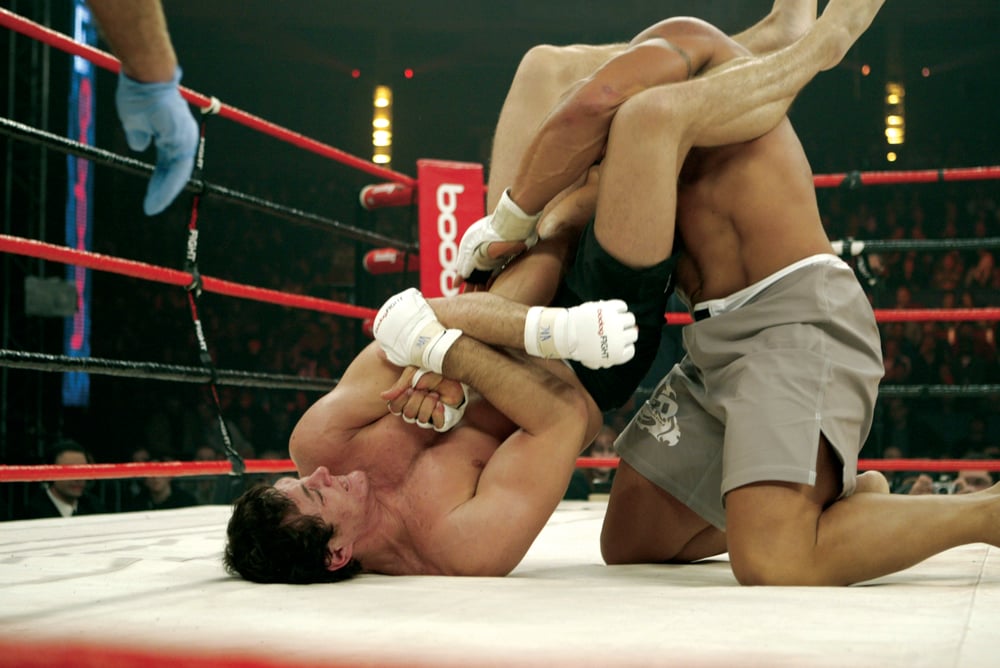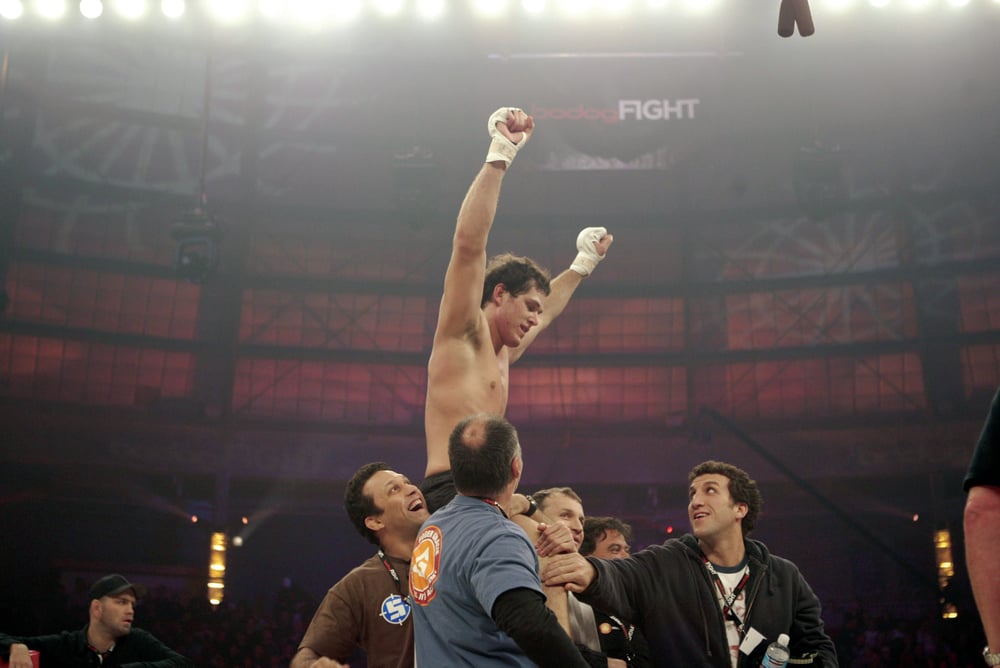
Issue 022
February 2007
The West London borough of Ladbroke Grove may not be the first place you’d think of as a centre for Brazilian Jiu-Jitsu, But sure enough, tucked away in a maze of industrial backstreets, the Roger Gracie Academy has as its owner one of the world’s best grapplers and a real star in the making on the MMA heavyweight scene. Fresh from his schooling of the powerful wrestler Ron Waterman, Roger spoke to Jim Page about his latest sporting endeavour, his academy and the challenges he faces returning to the mat.
An unparalleled grappler, Roger Gracie did his family name no shame and made history at the 2005Abu Dhabi submission wrestling championships, finishing 7 of his 8 matches by submission to claim the heavyweight tournament and his place in grappling history. “From that tournament I have great memories, I thought that that was my best tournament. I think I had the best results in one single tournament – it wasn’t that I submitted everyone – it’s that every fight was hard, but in the end I managed to finish them all. Some fights I had to fight 30 minutes, so it was a really, really hard tournament.
“I managed to submit them in the end, but especially winning the last match was relief from all for the fights that I had for over two hours. I was sore for over a week with the pain of the fight, but in the end, I have good memories from that.”
Asked which of his opponents he had most difficulty with en route to his win, Roger was quick to answer, “The most difficult to submit was the only one that didn’t submit – that gave up – was Cachareco, he didn’t come back to fight after 30 minutes. It was a draw until he gave up. He’s very short and very big; it’s hard to do anything with him because he didn’t move much. He was very explosive.”
Roger was the first to point out, however, that MMA competition is a different kettle of fish to the grappling tournaments that he has competed in. “It’s something new that I’m not really used to, but I’ve been boxing for a while, nothing professional, nothing very consistent, but here and there when I can, I train some boxing – which I love. To fight in the ring, it’s definitely different to fighting on the mats!”
Aware of the transitions that need to be made between grappling and MMA, Roger explained his views on the challenges that strikes on the floor pose for his game;
“I think it changes everything because the way of fighting is completely different – at any moment you can get punched and that causes a lot more danger. The way that you try to hold your opponent, to control them, is completely different.
“It’s not easy… the techniques that you do have to change, you get a lot more specific, you can only use certain kind of moves because of the fact that you can get punched, you can’t get so comfortable, you have to hold your opponent all the time.”
Taking on new skills in preparation for his tough debut fight with Ron Waterman was no problem for the young Brazilian. As he explains, his family has a well of MMA experience in Renzo Gracie. “Renzo’s a fantastic guy! He has been fighting and concentrating on MMA for many years now – he even stopped fighting grappling, only doing MMA. His whole way of training is directed towards MMA, every technique, you know, so he’s a great guy to have
on the side to push your training. I think he’s fantastic; he’s the best guy to be in your corner.”
Which ever way you look at it, fighting Ron Waterman in your debut in front of a massive pay-per-view audience is quite a daunting task and, humbly as ever, Roger reflected positively on the experience, but also seemed determined to learn as much as he could from it. “It was good, but I think that I have to change some aspects of my mind for that kind of fighting. My whole life I’ve been used to starting the fight relaxed, I’m not a very explosive person, so every time I fight I start slow and progress with the fight. But with MMA it’s different. If he’s trying to knock you out in the first two minutes, you can’t
get relaxed.
“The moment that I felt a bit worried was when he took me down and passed to my side. It was at that stage that I realised that I was at a disadvantage and I had to work to get myself in a better position because things could get bad if he started to
punch me. When I put him back in the guard I knew I was safe – it’s just a punch, but under the side I was worried.”
Established for three years, the Roger Gracie Academy is the culmination of family history in England and the many back and forth trips made by Roger as a youngster. “My father used to live here, I’ve lived here for 5 years and every year I used to come and spend maybe two months with him, help him teach. When he decided to move back to Brazil, at that point I was a brown belt, almost a black… I was to decide, I knew I always had an idea to come here and carry on and when I got my black belt I decided. I knew a lot of people here - a lot of people who could help me out at the beginning to open the place, so everything was already there, so I decided to move here.”
With a word for anyone interested in learning Jiu-Jitsu, Roger went on, “The first step that anyone has to do is come to the academy… everything comes with dedication, you have to dedicate yourself, you have to train at least 3 hours a week, you will progress – even if you don’t want to. Just keep training and try to enjoy it as much as you can – it will change your life!”
Demonstrating real pride in sharing the Gracie Jiu-Jitsu tradition, Roger revealed what he finds the most valuable return for his effort, “A lot of people, what they want in their students is to have a guy with natural talent, you need to teach him half of the move and he’s able to do the complete move. What really makes me happy is when you see someone – he’s never done martial arts before, he doesn’t have any physical, natural skills - and you help him to improve and at the same time with jiu-jitsu, you see him becoming a better person, which I think is the most important thing when you’re teaching somebody, that improvement is the biggest return that I can get from my students, what makes me happiest.”
On the other side of the coin, however, Roger explained what seemed to be his primary motivation for putting in the hours in the gym, “What I enjoy most is to compete against high level fighters. That is my motivation. It’s not just about fighting. If I fight in a tournament and there are not any top fighters there I don’t have any motivation. But when I’m fighting in a tournament where I know all the top guys are going to be there, that’s my motivation, that’s what makes me train really hard. I have to keep up my condition, physical and mental, to be able to compete at the peak of my ability. I try to train at least four hours a day, 6 days a week. Some days, if I’ve trained too much, I relax and then the next day I train a little better, but at least four hours.”
Outlining his theory about training and recovery, Roger continued, “I always try to take a nap and what you eat is very important… Everything is as important as everything else; the sleep that you have is as important as the training that you do… because if you don’t sleep well, you won’t be able to train well, everything has to be connected. The training, the nutrition, the recovery. You train then you eat, then take a nap – at least two hours in the afternoon. Then you wake up, eat a little bit and you’ll be ready to train.”
Asked where his focus was going to be for the coming years Roger replied with tantalising prospects for both MMA and grappling fans around the world, “Definitely both. I started off grappling and jiu-jitsu, I had my first MMA fight just now, but I’m going to take some time out to train for the Abu Dhabi superfight next year and for the World Championships, with the gi. [Newly formed MMA organisation] Bodog was really well organised, I’ll probably fight for them again – then possibly PRIDE soon…”
Fighters Only would like to thank www.bjj.eu.com and Urban Gorillaz for their assistance in organising this interview.
...











